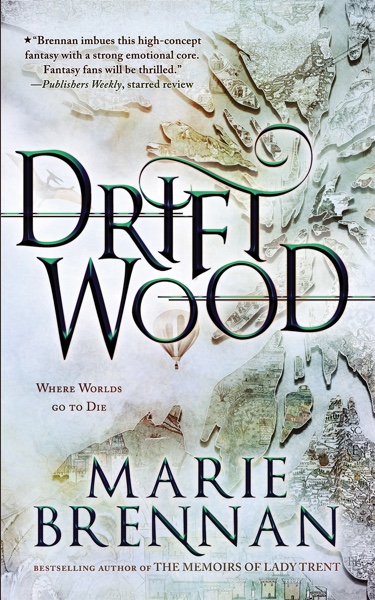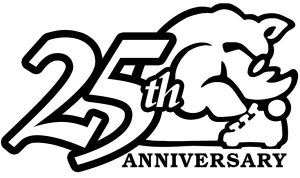Eye on the Indies:
A Look at Indie Authors and Their Publishers
By Lanie Tankard, Indie Book Review Editor
Driftwood by Marie Brennan (San Francisco: Tachyon, August 14, 2020; 224 pages; $15.95 trade paperback: ISBN 978-1-61696-346-0; $9.99 digital formats: ISBN 978-1-61696-347-7).
“Thus sang Úlfr Uggason:
‘….With old tales the hall was painted.’”
—Snorri Sturlson, The Prose Edda
(SKÁLDSKAPARMAL, p. 100)

Once again, prolific author Marie Brennan has melded her background in anthropology and folklore with her imagination—this time to build a world called “Driftwood,” the first novel in a fresh fantasy series. Her name for this universe is inspired.
The word driftwood, on its face, simply refers to pieces of wood floating on the sea, often brought ashore by the tide. If one delves into figurative language, however, it’s easy to view the expression as something rootless, pushed around by a force greater than itself—somewhat like “The Old Man of the Lake,” a giant hemlock floating upright in Oregon’s Crater Lake for more than a century. The Inuit peoples certainly found numerous ways to employ that nomadic vision, and Norse mythology made liberal use of driftwood symbols.
Brennan’s novel could be taken as an allegory signifying not only the fictional scope she created but also the actual one of our current times. For what she presents is a Götterdämmerung, the collapse of a disordered world, one she dubs “Driftwood.” Here entire continents disintegrate by various means into neighborhood chunks as gravity pulls them one by one to the center—the Crush, from which nothing emerges.
Driftwood is a collage of broken realms attached willy-nilly. Day and night, seasons, weather, moons, terrains—they all differ even from street to street. The sea disappeared long ago. Each world has its own characteristics, culture, customs, emotions, and language. Races vary. The Kakts are red, for example, while the Valraisangenek have green skin. All these distinctions produce suspicion of “the other.”
Six of the seven stories previously appeared in print elsewhere, which on occasion slows the book’s flow. Only “The God of Driftwood” is original to this book. Sometimes a character will reappear in other chapters though, such as Febrenew, the barkeeper.
A tall guide with silvery-blue skin named Last ties each narrative to the others with his first-person voice. He is a “one-blood” who has remained long after his world vanished many lifetimes ago. Word travels, and everyone wants to know Last’s survival secret. When a rumor of his demise swirls through an area called the Shreds, Drifters gather in the remnants of an old amphitheater called Quinendeniua, or the Court of Memory, to recount his feats.
Tolyat, a scholar who wanted to make a map, remembers going up in a hot-air balloon with Last so they could look down upon the whole. It was the first time either had ever seen Driftwood in its entirety, even in Last’s long life. Tolyat recalls water on Last’s cheeks, and wondered if that was what other races called “tears.” Tolyat finally understands the price of endurance Last paid. To last is to continue to live as the only one remaining. While Last mourned his own ancient civilization, he was forced to watch as arbitrary boundaries terminated other worlds.
“We destroy each other,” Tolyat realizes in horror.

Author photo by Perry Reichanadter
As stories continue in the Court of Memory, it becomes clear that eventually Last just wanted to forget all that he’d witnessed. In Driftwood, Brennan ponders borders, racism, and hate in her own subtle way, but it’s reminiscent of Ursula K. Le Guin in The Left Hand of Darkness (p. 212): “…what is the sense of giving a boundary to all that, of giving it a name and ceasing to love where the name ceases to apply? What is love of one’s country; is it hate of one’s uncountry?”.
In a sense, Last for Brennan serves the same purpose as did Genly Ai for UKLG in Left Hand, bearing witness while traveling through disparate domains in demise.
In other literary gestures, Brennan also weaves in biblical allusions, brings to mind the Icelandic sagas of Sjøn’s CoDex 1962, and nods to H. P. Lovecraft’s short story “The Call of Cthulhu” with a character named Ctarl. In Lovecraft’s world of Mythos, Cthulhu represented existential dread of the unknown. In Brennan’s world of Driftwood, Ctarl finally faces down his fear of the Crush when terrors in his known world outweigh those in the unknown. Brennan inserts another wink at the end of her book with a riff on Lovecraft’s quote: “…the world is indeed comic, but the joke is on mankind” (from his essay “The Defence Remains Open!” in the collection In Defence of Dagon).
At Driftwood’s conclusion, only two characters remain in the world of Paggarat: Aun and Esr. They echo the first humans in Norse myth, Ask and Embla, who were formed from an ash and an elm out of driftwood. Brennan has Aun and Esr walk, with hands joined, smiling until the end of their world—sans fear. No need, for they have lasted. It’s a poignant reverberation, once again, of UKLG:
Light is the left hand of darkness
and darkness the right hand of light.
Two are one, life and death, lying
together like lovers in kemmer,
like hands joined together,
like the end and the way.
(The Left Hand of Darkness, p. 233)
Both authors, Brennan and Le Guin, are well grounded in anthropology and make use of myth in their numerous books. Why would that be relevant? Perhaps it’s because stories have warmed civilizations for eons on this planet, through floods and wars and pestilence and pandemics. Facing the world through fiction during such times softens their harsh reality. Parables, legends, tales, fables, and lore have all served humankind well for millennia.
Memories and metaphor—they’re what drive stories. And we need stories more than ever today as we float six feet apart in the increasingly turbulent waters of a coronavirus sea. Books such as Driftwood act as life preservers in our isolation.
What if Last’s memory were wiped out? Other Drifters vow not to forget. Storytelling becomes their ultimate technique of preservation—keeping the old worlds alive through remembering, one generation passing a baton to the next while realizing, as James Baldwin poignantly observed, “one day, for each of us, the sun will go down for the last, last time” (“Letter from a Region in My Mind” in The Fire Next Time).
We’re lucky to have the imagination of writers like Marie Brennan right now to keep us afloat amidst the flotsam and jetsam of COVID-19. Driftwood is a life preserver.
Marie Brennan is the pen name of Bryn Neuenschwander, who also writes under the shared nom de plume of M. A. Carrick with Alyc Helms. They are coauthors of the forthcoming Rook and Rose fantasy trilogy from Orbit Books.
Brennan‘s Victorian Age science fantasy series, The Memoirs of Lady Trent, was a finalist for both the 2018 Hugo Award for Best Series and the 2019 Grand Prix de l’Imaginaire for Best Foreign Novel. The first book in the series, A Natural History of Dragons (2013) won the 2016 Prix Imaginales in France for Best Translated Novel and was a finalist for the 2014 World Fantasy Award. The final book, Within the Sanctuary of Wings (2017), won the 2017 RT Reviewers’ Choice Award for Best Fantasy Novel.
Her other books include a two-part Doppelganger work, Warrior and Witch (2006), and the Onyx Court historical fantasy series set in London: Midnight Never Come (2008), In Ashes Lie (2009), A Star Shall Fall (2010), and With Fate Conspire (2011). Brennan has also written the urban fantasies Lies and Prophecy (2012) and Chains and Memory (2016), as well as several short-story collections.
She is author of an annual series of guides called New Worlds: Essays on the Art of Worldbuilding, and has written fiction and setting material for several game lines, including Legend of the Five Rings and Tiny d6.
Brennan is a member of the Book View Café authors’ cooperative, and has taught creative writing workshops. She earned a bachelor’s degree in archaeology and folklore from Harvard University, where she was cochair of the Harvard-Radcliffe Fiction Association, and has done graduate work in folklore and anthropology at Indiana University Bloomington.
Publisher: Tachyon Publications
 Tachyon Publications in San Francisco is an indie publisher of “smart science fiction, fantasy, and horror, as well as occasional mysteries, memoirs, young adult, and literary fiction.” In physics, a tachyon is a hypothetical particle that travels faster than light but has never been observed. Since physicists don’t actually know whether tachyonic particles exist, they can only predict them in their imagination—which is, of course, just what writers do.
Tachyon Publications in San Francisco is an indie publisher of “smart science fiction, fantasy, and horror, as well as occasional mysteries, memoirs, young adult, and literary fiction.” In physics, a tachyon is a hypothetical particle that travels faster than light but has never been observed. Since physicists don’t actually know whether tachyonic particles exist, they can only predict them in their imagination—which is, of course, just what writers do.
Publisher and Editor Jacob Weisman founded Tachyon Publications in 1995. He shared the 2018 World Fantasy Award for Best Anthology with Peter S. Beagle for their coedited book The New Voices of Fantasy. Weisman’s writing has appeared in publications such as The Nation, Realms of Fantasy, Louisville Courier-Journal, Seattle Weekly, and Cooper Point Journal. He and his wife, Rina Weisman, coordinate SFinSF (Science Fiction in San Francisco), a monthly series of movies and author readings (hosted by Terry Bisson).
Managing Editor Jill Roberts began her work at Tachyon in 2002. She has been a columnist for the library newsletter Books to Watch Out For and also for the feminist literary magazine 13th Moon. Roberts worked as consulting editor at Streetside Stories, a Bay Area nonprofit writing program cultivating the voices of young people from underrepresented communities.
Baker & Taylor Publisher Services in Ashland, Ohio, distributes Tachyon to the book trade. Tachyon submissions are open only to literary agents, artists, and designers (but not authors representing themselves).
Copyright 2020 Woven Tale Press LLC. All Rights Reserved

